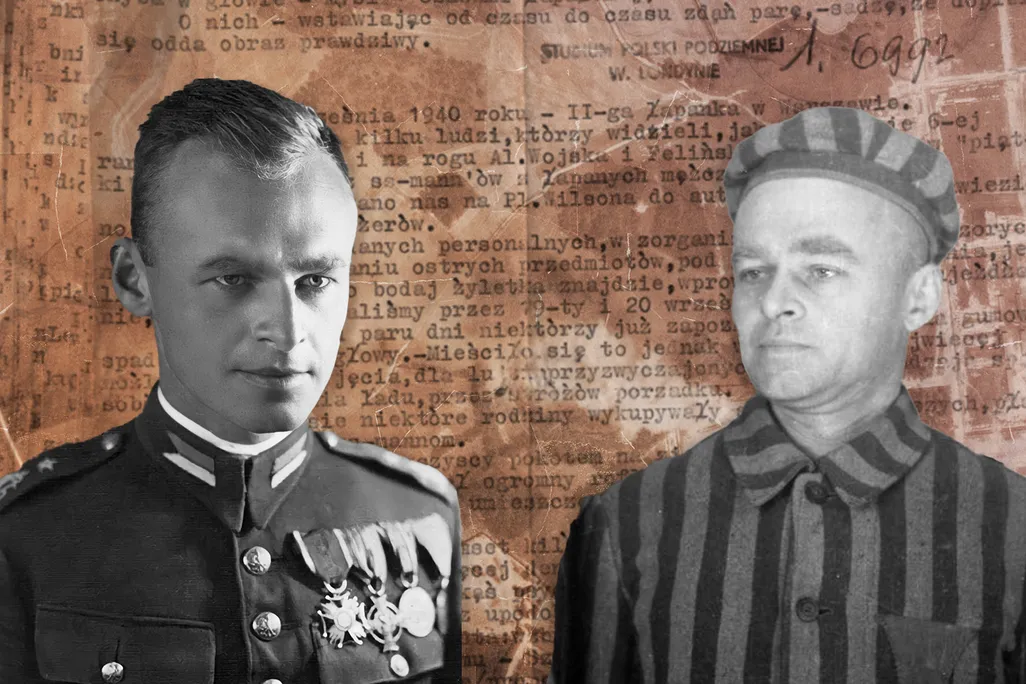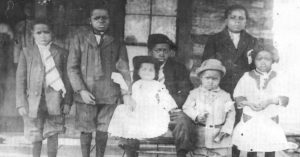Witold Pilecki smuggled reports about Germany’s war crimes to the Allies, urging them to stop the atrocities at Auschwitz by bombing the camp. But his warnings went unheeded
Paul HockenosMay 8, 2025 6:00 a.m.

In September 1940, the Polish underground resistance fighter Witold Pileckiundertook a monumental act of bravery: He volunteered to allow the Nazi forces occupying Poland to arrest him, in the expectation that they would incarcerate him in the Auschwitz concentration camp.
At the time, the newly constructed Nazi facility in southern Poland hadn’t yet assumed its ultimate incarnation as Adolf Hitler’s seminal death camp. The internment center functioned more like a prison for convicted German criminals; a small number of Jews; and Polish oppositionists, including members of the Secret Polish Army, Pilecki’s outfit. Yet from its first days, Auschwitz bore a reputation for extreme brutality.
The Polish underground initially hoped that it could liberate Auschwitz from within the camp’s walls. The clandestine network selected Pilecki, a 39-year-old veteran and fervent Polish nationalist, to infiltrate Auschwitz, report on its operations and organize fellow prisoners with the object of overthrowing the German camp’s superintendents. Pilecki, the secret army’s chief of staff, carried out this Hail Mary mission over a period of two and a half years. Although the Polish freedom fighters couldn’t incapacitate the Nazis’ operation, Pilecki and his cohorts smuggled descriptive reports out of the facility as it morphed into Europe’s most heinous death factory, where more than 1.1 million people died, nearly one million of them Jews.
/https://tf-cmsv2-smithsonianmag-media.s3.amazonaws.com/filer_public/13/5f/135f8a59-4073-422e-830e-b01f4f74a140/aerialauschwitz1944.jpg)
Over the course of 1942, Pilecki correctly grasped why the Nazis were enlargingthe camp complex by adding gas chambers and crematoriums. He repeatedly urged the Polish exile government in London to convince the United Kingdom’s Royal Air Force to bomb Auschwitz, even if it meant killing innocent victims in the camp, including himself. Pilecki’s reports provided some of the earliest evidence of the Nazi death camps and their function in what the Nazis labeled the “Final Solution,” or the extermination of Europe’s Jews, known since as the Holocaust.
Pilecki’s credentials made him a logical candidate for this harrowing job of subterfuge and sabotage. Born in 1901 to patriotic Polish Catholics living in the Russian Empire, the teenage Pilecki served as a scout for Polish self-defense units during World War I. After the global conflict ended in 1918, he fought in a cavalry unit in the Polish-Soviet War, a 1919 to 1921 conflict between Polish nationalist forces and the Soviet Red Army over territory in present-day Ukraine and Belarus. While serving as a reserve officer in the mid-1920s, he took over his family’s estate, and in 1931, he married elementary school teacher Maria Ostrowska. The couple had two children; Pilecki painted and wrote poetry in his free time.
But Hitler’s war machine shattered the family’s harmony. On September 1, 1939, the Nazis invaded Poland, and two weeks later, the Soviets attacked from the east. Pilecki mobilized a reserve unit of local men he’d trained over the summer, but most of them were “peasants who had never seen action or fired a gun in anger,” writes journalist Jack Fairweather in The Volunteer: One Man, an Underground Army and the Secret Mission to Destroy Auschwitz. In a little over a month, the Polish Army was defeated, and the country of Poland came under Nazi and Soviet occupation.
/https://tf-cmsv2-smithsonianmag-media.s3.amazonaws.com/filer_public/50/a0/50a0edf8-0114-4e91-b58a-b8c79c05c454/druzyna_harcerska_z_ora_n_oka_1917_witold_pilecki_witold_ferchmin.png)
Pilecki, like thousands of other Polish soldiers and civilians, joined an underground opposition that battled the occupiers from forests, sewer systems and cellars, notes a permanent exhibition on Pilecki’s life at the Pilecki Institute in Berlin.
The Nazis met the Polish resistance with a prodigious campaign of terror. Their plan was to murder or force Poles, whom they viewed as racially inferior, to flee in order to open the territory of Poland to German expansion. Jewish Poles were largely confined in fenced-off city districts, like the notorious Warsaw Ghetto, the largest of its kind in Europe. The mass arrests, at first of mostly non-Jewish Poles, led the Nazis to construct new prison camps or refurbish existing structures, like the former military barracks in Oswiecim, Poland, which opened as the Auschwitz concentration camp in June 1940. The cynical injunction “Arbeit macht frei,” or “Work makes you free,” loomed over its entry gate.
“The Polish underground movement couldn’t know what Auschwitz would become, but it had genuine interest in knowing what was going on inside,” says historian Jochen Böhler, director of the Vienna Wiesenthal Institute for Holocaust Studies. “The resistance astutely infiltrated a number of Nazi facilities, including the Warsaw Ghetto, where it passed on information about the disastrous conditions and mass dying of Warsaw’s Jews there.”
The choice of Pilecki to lead the high-stakes mission wasn’t based on his qualifications alone. An internal struggle within the Polish Secret Army enabled one of Pilecki’s rivals to suggest him for the job. But the final decision lay with Pilecki, and he mulled it over for days—the implications for his family could be severe if he were outed as a partisan. Then he took the plunge: “I bade farewell to everything I had hitherto known on this earth and entered something seemingly no longer of it,” he later wrote.
/https://tf-cmsv2-smithsonianmag-media.s3.amazonaws.com/filer_public/c6/e5/c6e54986-99ce-4d28-9f88-5a4e2759ea02/witold_pilecki_kl_auschwitz.jpg)
On September 19, 1940, Pilecki was arrested during a street roundup in Warsaw. He was not immediately executed, as was the fate of some Polish prisoners, but rather transferred to the Auschwitz facility two days later. Pilecki’s prisoner file, number 4859, displays the false identity he presented upon arriving at the camp, using the papers of one Tomasz Serafiński, a Polish lawyer born in Warsaw in 1902. The file includes photos of Pilecki in cobalt blue-and-white striped prison denims at three angles; his shorn head accentuates his high forehead, aquiline nose and bushy eyebrows.
Pilecki’s jobs at the work camp included laboring in the fields, where he toiled in early winter in wooden clogs without a hat or socks. Another task was insulating the camp’s lone crematorium, which disposed of the day’s dead; it could burn 70 corpses in 24 hours—far fewer than the 4,000 to 8,000 bodies burned in Birkenau’s four crematoriums each day by June 1943. At one point, Pilecki helped build a villa adjacent to the camp, where Auschwitz commandant Rudolf Höss and his family resided, as featured in the Academy Award-winning 2023 film The Zone of Interest.
The guards lavished the Poles with brutality. They were bullied, beaten, humiliated, tortured and shot, with productive laborers crammed on top of one another in the dirty stone barracks—separately from the Jewish prisoners, whose numbers grew ever larger. The object was to break the roughly 5,000 inmates, etching into their minds that resistance of any kind was futile.
The indoctrination began the moment the prisoners arrived. “We had our heads and bodies shaved,” Pilecki wrote. “It was here that I had my first two teeth knocked out, the reason being that I was carrying the registration number in my hand instead of carrying it in my teeth. … I got hit in the jaw with a heavy rod.”
/https://tf-cmsv2-smithsonianmag-media.s3.amazonaws.com/filer_public/8e/8c/8e8c9efd-f054-4256-95cd-e40a69345a12/view_of_the_entrance_to_the_main_camp_of_auschwitz_auschwitz_i.jpg)
Rule violations that could result in a beating or worse were manifold, including talking, smoking, moving too slowly, running the wrong way, loitering and saluting an SS officer incorrectly. For every prisoner who escaped from this hell, ten others would be executed—a policy that led Pilecki to forbid other underground fighters at Auschwitz to attempt to escape, as he later recalled in a report.
Every morning, prisoners lined up for inspection alongside the corpses of those who had died in the night heaped in a pile next to them. As the size of the camp expanded, officials filed requests to construct more effective crematoriums. Out of the guards’ earshot, Pilecki recruited the most dependable of his compatriots to help pass along information to the resistance.
Pilecki selected partisans from members of the Polish underground who were either already in the camp or who’d arrived after him. Together, they identified trusted comrades pending release—some were set free after a sentence was served—to relay reports back to the resistance command in Warsaw. From there, the information was forwarded to the Polish government in exile in London, which then shared it with Britain and the other Allied Powers. (Pilecki also managed to write to his wife and urge her not to try to buy his freedom, as he thought his work undercover was bearing fruit.)
A young Polish officer, Aleksander Wielopolski, memorized Witold’s first report, delivering it to Warsaw in October 1940 as an oral account of the camp’s atrocious conditions, and the widespread abuse and murder of prisoners. This report was among the first to reveal the systemic violations of international law perpetrated by the Nazis. It also contained details of Auschwitz’s layout, including its warehouses and the possible sites of weapons and ammunition.
/https://tf-cmsv2-smithsonianmag-media.s3.amazonaws.com/filer_public/84/88/8488ed34-8ca2-4b95-8caa-d684e07d8daf/birkenau_jewish_mothers_and_their_children_walking_to_the_gas_chambers.jpg)
The report’s conclusion included a shocking, unexpected appeal from Pilecki, who later said he’d considered the request thoroughly over the course of his first months in Auschwitz. He found the conditions so barbaric and the camp’s security so tight that he asked for the Allies to destroy Auschwitz from the air.
“The prisoners beg the Polish government, for the love of God, to bombard these warehouses” and end their suffering, the report said, according to Fairweather’s biography. The logic was that the camp’s bombardment would occupy the security details and give the prisoners the opportunity to overwhelm the guards and escape. “Should [the prisoners] die in the attack, it would be a relief given the conditions,” the report concluded. Pilecki underscored that this was not his deduction alone, but those of his fellow Polish inmates, too.
The first reports didn’t cause much of a stir, however, as the U.K. was then under attack and fighting for its own survival amid the Blitz. “Pilecki’s reports from inside Auschwitz were extremely important for the Allies’ knowledge of what was going on inside the concentration camps in occupied Poland,” says Böhler. “The tragedy is that even as late as 1942 [and] 1943, the Western Allies did not react to the reports, so that the Nazi mass murder went on unhampered.”
Meanwhile, Auschwitz was expanding as the prisoners labored until breaking point to erect new walls, barracks, crematoriums and gas chambers. Two miles away, a second part of the camp, constructed by Soviet prisoners, took shape: Auschwitz II-Birkenau, which opened on the location of the demolished village of Brzezinka in early 1942. As the camp’s population grew, mostly with Jews and Soviet citizens but also Poles, so did Pilecki’s recruitment efforts. He later claimed he had cobbled together a force of several hundred men.
The Gestapo, Hitler’s secret police, combed the Poles’ ranks in search of men with experience in clandestine resistance organizations. Those suspected were yanked off work squads and executed. Thanks to his cover identity, Pilecki eluded detection. His subsequent reports, all carried in the heads of released prisoners, informed the Allies about Auschwitz’s development—and urged them to attack the camp—but Pilecki never heard mention of such plans while listening to the BBC on an illicit radio. Nor did Allied aircraft ever appear in the clouds over Auschwitz’s grounds.

In the fall of 1941, Pilecki passed on to the Warsaw command word of new extermination chambers where the camp’s sick and disabled were being murdered with Zyklon B, the fast-acting pesticide that would enable the Nazis to kill millions. Pilecki and his comrades didn’t know the full extent of the killings at the very beginning, and they failed to understand that the genocide of Europe’s Jews was happening at an industrial scale. Who could conceive of “an ideology of mass murder,” writes Fairweather, the idea of wiping out an entire group of people in the midst of a multifront war?
But the Polish prisoners soon grasped Hitler’s logic. “Jews from all over Europe were brought to Auschwitz,” Pilecki later wrote. “The Jews, after a couple of months of writing letters praising their conditions, were suddenly taken off various jobs and quickly killed.” Beginning in March 1942, trains carrying thousands of Jews arrived at the camp every day, and the Nazis worked as quickly as possible to gas and cremate the human cargo. “There were many women and children in these carriages,” Pilecki reported. “Sometimes babies in their cradles. Here they were to end their lives, all together. Like a herd of animals led for slaughter.”
The camp’s worsening conditions exacerbated Pilecki’s belief that the Allies had to either bomb the camp or take it by way of ground infantry. If they didn’t react soon, he warned in another report, the inmates would take it upon themselves to make the best of a revolt—although he suspected it wouldn’t end well. Over the course of two years, he had lost too many men to the Nazis’ firing squads and toxic injections.
The deadlines Pilecki gave to Warsaw came and went, but he ultimately refused to support a revolt or a mass breakout that would spell a bloodbath. Nevertheless, his fellow inmates hatched plan after plan, which at least helped boost morale.
The Allies’ infuriating refusal to act made it clear to Pilecki that he had to escape—and make the death factory real to them in person. “Reading testimonies and memoirs written by the fellow prisoners,” says Bartłomiej Kapica, a historian at the Pilecki Institute’s Center for Totalitarian Studies, Pilecki “always stressed that escape had to be bring something greater than just one person’s life. In his case, it was radical narrowing of the possibility to start an uprising in the camp and his feeling that the underground leadership did not understand what the camp was.”
But the odds of pulling off an escape were low: Of the 170 or so breakout attempts made in 1942, only about a dozen had succeeded, according to Fairweather. Yet in early 1943, Pilecki’s comrades felt they had located an option: an SS-overseen bakery outside the camp with an iron door that they had learned to jimmy. By tricking one of the wards, Pilecki had himself and two other men, Jan Redzej and Edward Ciesielski, transferred to the bakery.
As the night shift ended early in the morning of April 26, Easter Monday, Pilecki and his two compatriots muscled the door open and ran like rabbits from a fox. Shots rang out, but the escapees made it to the Vistula River and the forest line, where for days they traveled—mostly at night and with the aid of Polish locals along the way—through heavily patrolled, German-occupied territory. East of the city of Krakow, they landed in the village home of one of the trio’s former cellmates.
Finally free, Pilecki informed the underground’s leaders that an attack on the camp would be met immediately by a revolt from within, meaning it was in their power to liberate Auschwitz and demobilize the concentration camp. He summarized his experience in longer texts underscoring the massacre of Europe’s Jews in Auschwitz. These pleas went unheeded, too.
/https://tf-cmsv2-smithsonianmag-media.s3.amazonaws.com/filer_public/1f/d2/1fd2c34e-2154-4323-8389-393161df5694/1670px-stroop_report_-_warsaw_ghetto_uprising_08.jpg)
The Allied authorities failed to take Pilecki’s reports seriously, even as other communications came trickling in that addressed the same issue. The Allies were slow in grasping the systematic nature of the murder of Europe’s Jews; they also felt that even if these kinds of reports were factual, beating Hitler on the battlefield was the overwhelming priority, and liberating concentration camps would only happen after this was accomplished anyway.
“There is a never-ending debate on the question [of] if Auschwitz or the railways should or could have been bombarded,” says Böhler. “This is not only a logistical but also a moral question. Even if the result would have been merely symbolic, it would have set a powerful sign against genocide. But the Allies prioritized military victory over Nazi Germany. The mass murder of millions of Jews and other civilians before that was not really taken into account.”
Pilecki deemed it unwise to return to his family, as his wife, Maria, worked as a housekeeper for a German family. Though he managed to meet up with Maria, he would never see his son and daughter again. In 1944, he rejoined the Polish Home Army and participated in the Warsaw Uprising, in which the city’s Poles rose up against their Nazi occupiers. But without assistance either from the Allies in the west or the approaching Soviet Army in the east, the endeavor was doomed to failure, too. The grainy black-and-white photos of the vast fields of rubble illustrate the ferocity with which the Germans responded, leveling the city to cinders.
/https://tf-cmsv2-smithsonianmag-media.s3.amazonaws.com/filer_public/78/46/7846b840-9383-4264-aeb9-ef401933a59c/destroyed_warsaw_capital_of_poland_january_1945.jpg)
Pilecki’s life ended on a particularly bitter and darkly ironic note. As a man who had fought colonial and imperial lordship over Poland his entire life, he saw the Soviet occupation of his homeland after World War II as just another incarnation of foreign dictatorship. He went underground again, fighting until the Soviet-allied Polish secret police arrested him in May 1947. His own statesmen jailed and tortured him for over a year before executing him by firing squad on May 25, 1948. He was 47 years old.
Because underground resistance fighters were considered enemies of the state by the communist Polish regime, Pilecki’s surviving family members were treated as undesirables. His wife, notes Fairweather, who collaborated closely with Pilecki’s relatives while researching his biography, worked as a house cleaner in a Catholic orphanage.
Pilecki’s story went untold for most of the communist-run decades, for the obvious reason that it reflected badly on the Polish government. A Polish historian acknowledged Pilecki’s contributions to the Auschwitz underground in a 1975 book, but it was only with the Cold War’s end and the fall of the Soviet Union that scholars like Wiesław Jan Wysocki and Adam Cyra fully excavated his story by drawing on his reports, a memoir of his early life and other papers.
In 1990, Pilecki was exonerated posthumously and recognized for his wartime actions. As historian Norman Davies wrote in 2012, “If ever there was an Allied hero who deserved to be remembered and celebrated, this was a person with few peers.”
/https://tf-cmsv2-smithsonianmag-media.s3.amazonaws.com/filer_public/df/65/df65ca16-305e-4c15-80f2-7ebaf20ebcd4/gettyimages-2206487528.jpg)




